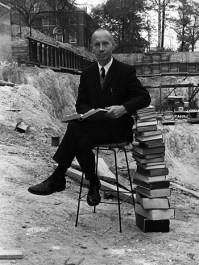Computer pioneer who helped create the first spreadsheet, Bob Frankston, is this week's guest.
Statuses
On a recent episode of Leo Laporte and Tom Merrit’s show Triangulation, they interviewed Bob Frankston of VisiCalc fame. They gave a great discussion of the current state of broadband in the U.S. and how it might be much better. They get just a bit technical in places, but it’s a fantastic and very accessible discussion of the topic of communications that every American should be aware of.
Reply to Mythbusters | The Sheridan Libraries Blog
Did Winston go down into the new hole for the BLC while they were digging and take a similar photo with a pile of books? The two photos would make great “book ends!”
Bill Davenhall at TEDMED 2009 on Geomedicine: How Your Environment May Affect Your Health
Does where you live have an impact on your overhall health? Bill Davenhall believes that the location of our homes is critical to our medical history.
This is a great thing to think about the next time your doctor asks for your medical history. Perhaps with more data and a better visualization of it, it may bring home the messages of pollution and global warming.
Matt Ridley’s Thesis: When Ideas Have Sex
At TEDGlobal 2010, author Matt Ridley shows how, throughout history, the engine of human progress has been the meeting and mating of ideas to make new ideas. It's not important how clever individuals are, he says; what really matters is how smart the collective brain is.
When extrapolated a bit, this thesis is one of the best arguments for why Twitter and other methods of social media are so useful. There really is a great idea at the core of this presentation.
Nicholas Bourbaki and Serge Lang
There’s an old mathematicians’ joke that goes like this:
Q: When did Nicholas Bourbaki quit writing books about mathematics?
A: When (t)he(y) realized that Serge Lang was only one person!
📅 DrupalCamp LA 2010 | August 7 & 8, 2010 at UC Irvine
Twitter Changes Rules on Users. No Auto-Follow. | Kyle Lacy
I’m personally glad they’d be implementing something like this and wish they had done it about a month ago. Eventually without any controls the site would have become a waste land. In the spirit of using it as the tool it has become, they needed to implement changes like this as the site scaled up to more and more people. It’s very similar to the changes they instituted in the fall of 2008 when they created a cap of being able to follow more than 2000 people when your own number of followers wasn’t commensurate with that number. As a game theorist, I’m sure that people will somehow find some other way to artificially game the system.
As a separate note, who really wants to waste the time building thousands and thousands of followers when none of them are really going to ever pay attention to you? Yes, it’s great to have a high number, but really what is your ultimate reach? How many people are you engaging?
Finished reading Induction and Intuition in Scientific Thought by P.B. Medawar
Originally published in 1969. This book explains what is wrong with the traditional methodology of “inductive” reasoning and shows that the alternative scheme of reasoning associated with Whewell, Pierce and Popper can give the scientist a useful insight into the way he thinks.
References:
- History of the Inductive Sciences by William Whewell (1837)
- Introduction à l’étude de la médecine expérimentale by Claude Bernard (Paris, 1865)
- Karl Popper
- Karl Pearson (math)
Acquired The Mathematical Theory of Communication by Claude E. Shannon and Warren Weaver
Scientific knowledge grows at a phenomenal pace--but few books have had as lasting an impact or played as important a role in our modern world as The Mathematical Theory of Communication, published originally as a paper on communication theory in the Bell System Technical Journal more than fifty years ago. Republished in book form shortly thereafter, it has since gone through four hardcover and sixteen paperback printings. It is a revolutionary work, astounding in its foresight and contemporaneity. The University of Illinois Press is pleased and honored to issue this commemorative reprinting of a classic.
Christopher J. Aldrich, Engr ’96, of Los Angeles, writes:
“I recently booked Bea Arthur into two episodes of the TV show “Malcolm in the Middle,” for which she received an Emmy nomination. Following this, I left Creative Artists Agency to join David Entertainment, where I helped to produce MGM’s Breakers, starring Sigourney Weaver and Jennifer Love Hewitt. Now I’m preparing for production of Doctor Doolittle 2, starring Eddie Murphy and Behind Enemy Lines, with Gene Hackman and Owen Wilson.”
“I recently booked Bea Arthur into two episodes of the TV show “Malcolm in the Middle,” for which she received an Emmy nomination. Following this, I left Creative Artists Agency to join David Entertainment, where I helped to produce MGM’s Breakers, starring Sigourney Weaver and Jennifer Love Hewitt. Now I’m preparing for production of Doctor Doolittle 2, starring Eddie Murphy and Behind Enemy Lines, with Gene Hackman and Owen Wilson.”
 library opened on November 15, 1964, there were just over 1.1 million books on the shelves.
library opened on November 15, 1964, there were just over 1.1 million books on the shelves.